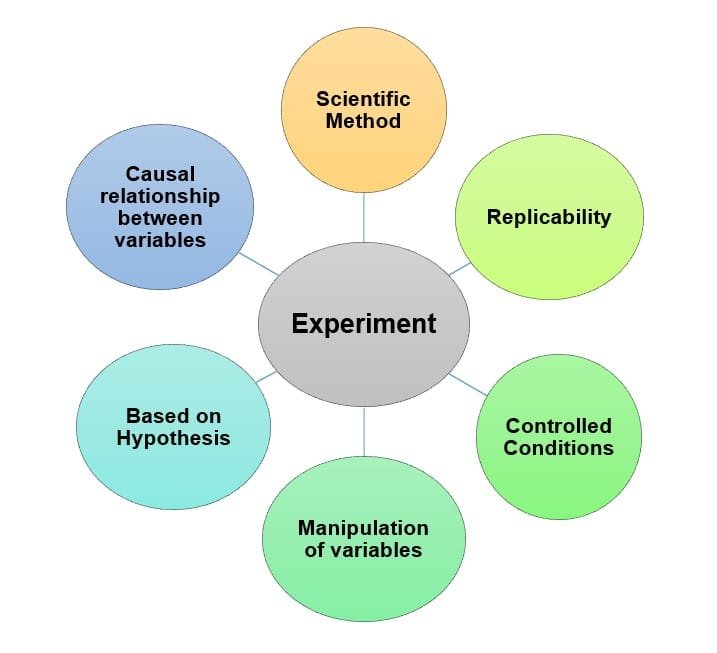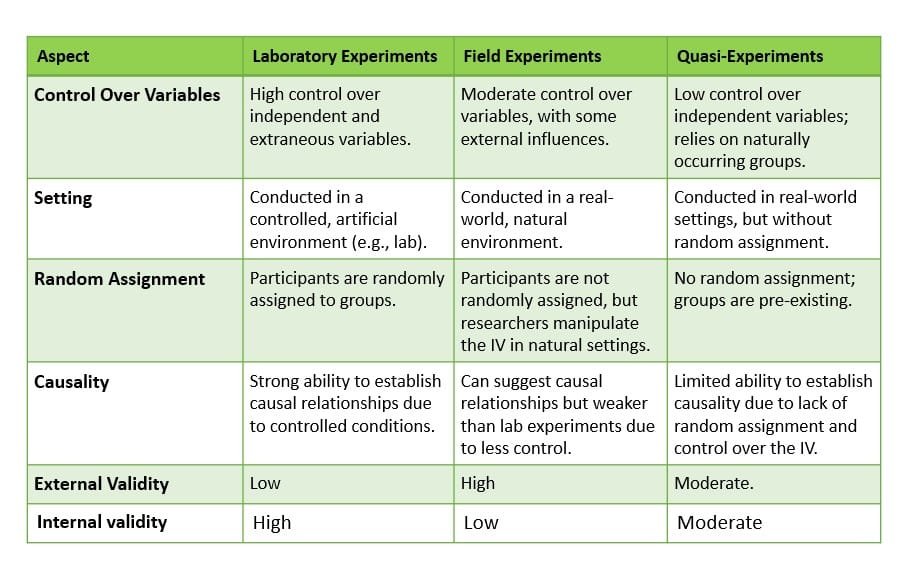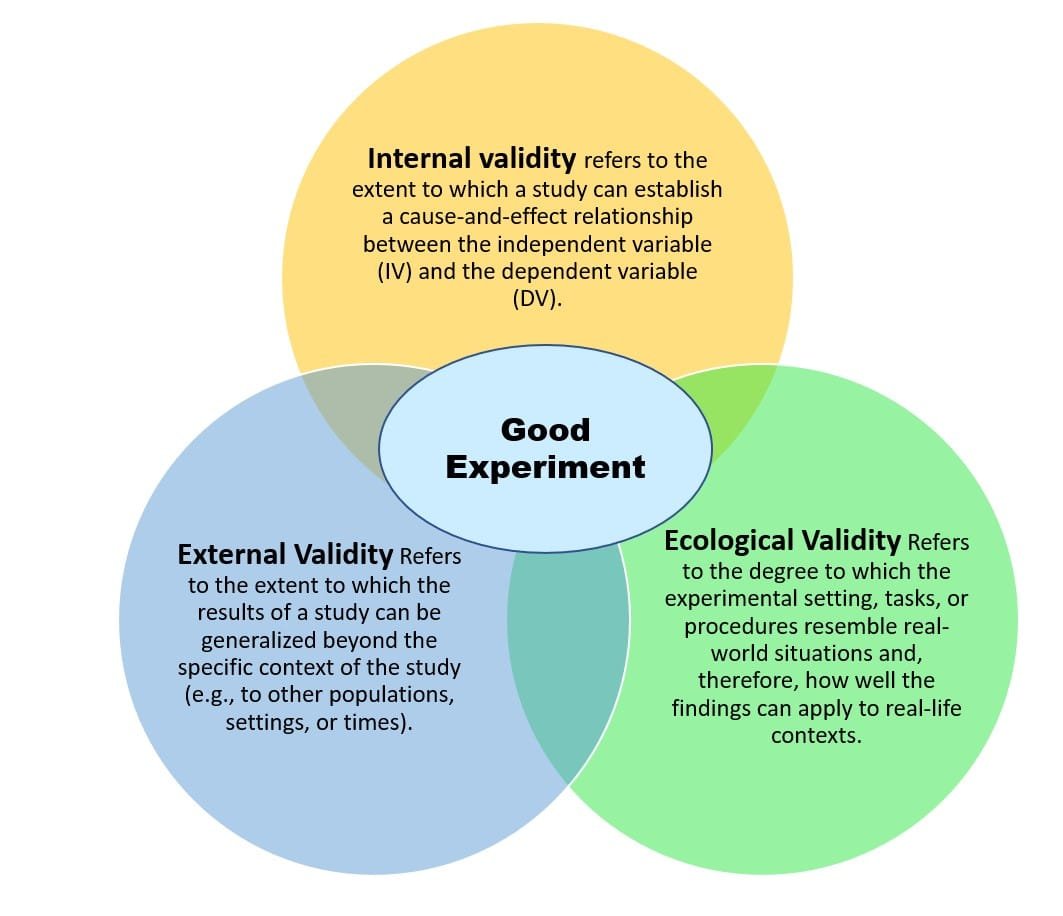Highlights :
- Experiments are vital for testing hypotheses and uncovering causal relationships between variables.
- Experiments are conducted under controlled conditions to ensure reliable results and minimize external influences.
- Learn about the three main types—Laboratory (high control, low ecological validity), Field (real-world relevance, less control), and Quasi-experiments (study variables without randomization).
- Experiments can be designed for confirmatory, exploratory or pilot purposes, depending on the research goals.
- Discover the strengths of each experiment type and when to use them for maximum effectiveness in your research.
Definition of Experiment
- According to American Psychological Association (APA), “An Experiment is a system of scientific investigation, usually based on a design to be carried out under controlled conditions, that is intended to test a hypothesis and establish a causal relationship between independent and dependent variables.”
- “An experiment may be defined as objective observation of phenomena which are made to occur in a strictly controlled situation in which one factor is varied and the others are kept constant” – Zimny, G. H.(1961).
Characteristics of an Experiment :
These definitions points out to some key characteristics of an Experiment :
- Scientific Nature : Experiments rely on systematic and objective procedures rooted in the scientific method. They are empirical in nature prioritizing tangible evidence obtained to test hypotheses. The results produced by the scientific method are often replicable under the same conditions, which increases validity of the experiment.
- Based on the hypothesis : Hypothesis is the educated guess or the informed assumption research has formulated before the experiment. It predicts the possible relationship between the variables. The purpose of the experiment is either to validate or falsify this assumptions using systematic methodologies.
- Causal Relationship between variables : They are designed to identify cause-and-effect relationships by manipulating one variable (independent) and observing changes in another (dependent). Cause-effect relationship refers to one variable directly causes the change in another variable. (**different from the correlation).
- Controlled Conditions : They tries to observe the purest form of the relationship between two variables without interference of any other factors with the help of strictly controlled environment. This helps to ensure that change in one variable is solely due to “assumed” variable only.

Characteristics of an Experiment
Types of Experiments :

Types of Experiments
A. Based on the settings –
1. Laboratory Experiments
- Festinger & Katz (1935), defined laboratory experiment (LE) as one in which investigator creates a situation with the exact conditions he wants to have and in which he controls some & manipulates other variables.
- According to Kerlinger (1986), there are three main purposes LE :
- They help to discover a relationship between dependent & independent variables under pure, uncontaminated & controlled conditions.
- They help in testing accuracy of the predictions derived from the research.
- They help in building theoretical systems, by refining theories & hypotheses and provide ground for scientific evaluation of them.
Strengths of LE –
- They are conducted in pure, controlled environment, hence the conclusion drawn from them are more dependable and has great internal validity* due to maximum control over EVs.
- They provide a great degree of precision in manipulation of the IVs.
- The randomization is possible, avoiding any bias or subjectivity.
- They are replicable.
Limitations of LE –
- LE are considered as artificial and little bit deviated from real-life situations. Hence, they lack ecological validity**.
- Some situations due to their physical impossibility can not be studied in labs, hence have low external validity**.
- They are costly as well as time-consuming.
Example: The Stroop Effect (1935)
- Objective: To investigate cognitive interference and attention by measuring reaction times.
- Procedure: Participants are asked to name the ink colour of words printed in incongruent colours (e.g., the word “RED” printed in blue ink). Reaction times and errors are recorded.
- Setting: Controlled LE with standardized procedures to minimize external influences.
- Why Laboratory: The environment allows precise control over variables such as task conditions, lighting, and instructions.
2. Field Experiments
- According to Shaughnessy & Zechmeister (1997), when the experimenter manipulates one or more independent variables in the natural setting for determining their effect on the behavior, the procedure is known as field experiment (FE)
- FE are carried out in more/ less realistic settings like hospitals, shopping complex, street corner, etc. where behavior can be identified. It is unlike LE which are conducted in artificial environment.
- FE manipulates independent variables and controls possible extraneous factors as the situation permits.
Strengths of FE :
- They deals with realistic life situations, hence more suited to study social changes, processes and influences.
- They have a high degree of ecological validity as well as external validity.
Limitations of FE :
- They gives lesser control over the variables due to uncertainty, lack of noticeability, non-cooperation form the subjects than LE.
- It is not possible to achieve a high degree of precision due to some uncontrolled environmental variables.
All this leads to poor internal validity.
Example: The Good Samaritan Study (1973) by Darley and Batson
- Objective: To examine the influence of situational factors (time pressure) on helping behavior.
- Procedure: Seminary students were sent across campus to deliver a talk. On the way, they encountered a person slumped in an alleyway. Some were told they were running late, while others were not. Researchers observed who stopped to help.
- Setting: Real-world environment (a university campus).
- Why Field: Conducted in a natural setting with participants unaware they were part of an experiment, enhancing ecological validity.
3. Quasi Experiments
- The word “Quasi” means “resembling like“. Hence, Quasi-experiments (QE) involve procedures that resemble those of true experiments.
- Campbell and Stanley (1966) explain, quasi-experiments arise when researchers lack the control necessary to perform a true experiment (LE/ FE). Most of the times they are performed in the natural settings to evaluate the effect of certain interventions or treatment of the population.
- QE are research designs where the independent variable (IV) is not manipulated by the researcher, and participants are not randomly assigned to groups. Instead, researchers rely on naturally occurring groups or conditions to study relationships between variables.
Strengths of QE –
- They are very useful to seek balance between internal validity and external validity.
- Since they are generally used to test effectivity of interventions, they posses high ecological validity.
- They are suitable where direct manipulation of variables is unethical.
- They are often cheaper and easier to implement than true experiments since they use existing conditions.
Limitations of QE –
- Since there is NO random assignment, it’s harder to establish a clear causal relationship between the IV and DV. The internal validity is lower than lab experiments.
- Pre-existing differences between groups can influence results, making it difficult to rule out alternative explanations.
Example: Effects of Smoking Bans on Public Health
- Objective: To examine whether implementing public smoking bans reduces hospital admissions for respiratory issues.
- Procedure: Researchers compare health outcomes in cities with smoking bans to those without, using existing records.
- Setting: Naturally occurring groups (cities with or without bans).
- Why Quasi: The IV (smoking ban) is not manipulated by the researcher, and participants are not randomly assigned to conditions, making it a quasi-experimental design.

Difference in Lab, Field and Quasi Experiments
B. Based on the Purpose
1. Exploratory Experiments
- The experiment is conducted in a situation where little knowledge exists to formulate possible solution to the problem, is considered as Exploratory experiment.
- Since there is no substantial basis for predicting the effect of independent variable on dependent variable, hypotheses are poorly framed.
- The findings of exploratory experiment can be the basis for formulating a specific hypothesis for further study.
2. Confirmatory Experiments
- Confirmatory experiment is used to test a explicit hypothesis and confirm whether it true or not.
- There is sufficient amount of literature is available for the given hypothesis. With this hypothesis, researcher already has enough support of possible predictions of relationship between IV and DV.
- They are conducted to validate existing theories or findings, often in different contexts or with new data. The outcomes are expected to either confirm the theory’s predictions or show that the theory does not hold in a particular context.
3. Pilot Experiments
- Pilot experiments are small-scale, preliminary studies conducted before a full-scale experiment.
- They allow researchers to test the research design, including the methods of data collection, equipment, and protocols.
- They generate preliminary data that help researchers evaluate the reliability and validity of the measurements and variables, without investing much resources.
- They help identify potential problems or flaws in the experiment’s design, such as unclear instructions, issues with equipment, or unanticipated participant behaviors that could impact the larger study.
Conclusion :
Experiments are essential in scientific research as they allow researchers to test hypotheses and establish causal relationships between variables. By manipulating the independent variable and observing the effects on the dependent variable, experiments provide valuable insights into cause-and-effect dynamics. Key characteristics of experiments include control, hypothesis testing, and replicability, which ensure reliability and validity. They can be categorized based on their setting—laboratory, field, and quasi-experiments—each offering different levels of control and ecological relevance. Additionally, they can be designed for confirmatory or exploratory purposes.
The choice of experimental design should align with the research goals, the feasibility of manipulating variables, and ethical considerations. LE are ideal for controlled testing of hypotheses, while FE and QE offer greater ecological relevance but come with challenges in control and causality. A careful balance between internal and external validity, along with the nature of the research question, will determine the most appropriate experimental approach.
References :
- Ranjit Kumar (2006). Research Methodology: A step by step guide for beginners. N. D: Pearson Education.
- Robinson, P.W. (1976). Fundamentals of Experimental Psychology. Prentice Hall.
- Shaughnessy, J.J & Zechmeister, E.B. (1997). Research Methods in Psychology. (4th ed).
- Singh, A. K. (2006). Tests, Measurements and Research methods in Behavioural sciences. (5th ed). Patna: Bharati Bhavan.
- Zechmeister, J. S. Zechmeister, E. B. & Shaughnessy, J. J. (2001). Essentials of Research Methods in Psychology.
Subscribe to Careershodh
Get the latest updates and insights.
Join 14,331 other subscribers!
Niwlikar, B. A. (2025, February 17). Clear fundamentals of Experiments in Psychology : Part 1. Careershodh. https://www.careershodh.com/psychological-experiments-1/

